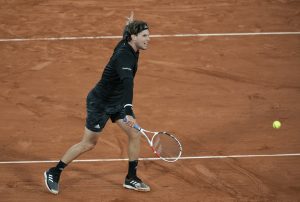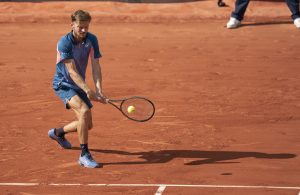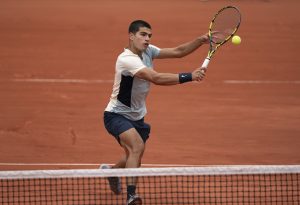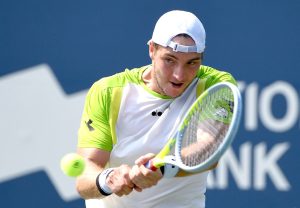The number 101 obviously does not possess the same sense of dread for Roger Federer that it did for George Orwell. For Orwell, 101 was the number of the room that was a torture chamber for Winston Smith and the other inhabitants of the future in 1984. For Federer, by complete contrast, 101 is now the number of ATP titles that he has won after his straight-sets and straightforward win over John Isner in the Miami Open Final. And in winning his 101st title so soon after his 100th a few weeks ago in Dubai, Federer has not only made it more likely that he will soon break Jimmy Connors’s record of 109 ATP Tour titles. He has also suggested that he might just make a success of his imminent return to clay after nearly three years away from the red dirt of Europe.
Federer was almost imperious against Isner in the Miami final. In the first set, he completely neutralised Isner’s impressive serve, which Isner’s Davis Cup captain, Mardy Fish, had recently said was the serve that he would choose if he needed someone to serve for his life. Well, Federer made that claim look absurd, as he first returned Isner’s serve with relative ease and then reeled off 21 successive points on his own serve to win the first set 6-1. The contest was much tighter in the second set, which went on serve until the very end, when Isner appeared to suffer an injury and Federer finally broke him again in the 10th game to take the match and the title.
Since the start of 2017, the period of Federer’s career that will surely come to be called “late (and great) Federer”, the Miami tournament has been an important staging-post for the Swiss maestro. In 2017, he completed “the Sunshine Double” by winning in both Indian Wells and Miami, both times beating Rafael Nadal, his old nemesis, in the final, as he had in the 2017 Australian Open Final, which began his recent resurgence. He then went on to win his eighth Wimbledon title without dropping a set, to establish himself as undoubtedly the greatest grass-court player ever, ahead of Wimbledon’s two seven-time winners, Pete Sampras and William Renshaw, who had dominated men’s tennis at the end of the 20th century and the end of the 19th century respectively.
In 2018, however, Federer lost in the Indian Wells Final to Juan Martin del Potro (having had three matchpoints to take the title) and then even more surprisingly lost early on in Miami to Thanasi Kokkinakis, the talented but inconsistent Australian. In fact, his difficulties last year on the Spring American circuit seemed to presage the second half of his 2018 season, when he failed to build on retaining his Australian Open at the start of the year by losing in the Wimbledon quarterfinals to Kevin Anderson and in the fourth round at the US Open to John Millman, an Australian who is even more inconsistent than Kokkinakis.
In 2019, Federer has enjoyed mixed fortunes in Indian Wells and Miami. He reached the final in Indian Wells and won the first set before succumbing to Dominic Thiem’s maiden Masters triumph. Then, in Miami, as if stung by the defeat to Thiem, he raised his game considerably, most obviously against Isner in the Final, to emerge triumphant. With Nadal missing the entire early season American swing of the tour through injury, and Novak Djokovic losing surprisingly early in both Indian Wells and Miami, Federer has ended the first part of the season in spectacular form, as shown by his replacing his Indian Wells conqueror, Thiem, as the World No. 4, behind Djokovic, Nadal and Alex Zverev.
However, there is of course something different about Federer’s schedule this year which makes it extremely difficult, if not impossible, to gauge how his impressive performances in Indian Wells and Miami might translate to the rest of the season. That is because, unlike in 2017 and 2018, he has decided not to skip the clay-court season in 2019 and instead he will compete in the great clay-court events in Europe, from Monte Carlo onwards, climaxing at Roland Garros at the end of May.
Federer elected to skip the clay court season for the last two years to try and maximise his chances of doing well in the rest of the season, particularly at Wimbledon, and it has to be said that his strategy worked brilliantly. He won Wimbledon in 2017, playing probably his finest grass-court tennis for a decade, and although he failed to defend his Wimbledon title in 2018, that was not down to any injuries or ailments that he had sustained on clay courts but to Kevin Anderson’s brilliant comeback against him from two sets down and, arguably, a little complacency by Federer after he had played so superbly against Anderson in the first two sets of their Wimbledon quarterfinal that he had made the South African look like a newborn giraffe tentatively taking its first steps.
It is fascinating to consider why Federer has made such a volte face this year and decided to return to clay. Indian Wells and Miami proved that, unlike Nadal and Djokovic, he is currently playing somewhere near the best of his ability and he will obviously hope to take that renewed form into the European clay court season, which begins at Monte Carlo in a fortnight. However, it is also undeniably true that not playing on clay for the last two seasons, which is surely the most attritional of surfaces for tennis, has paid off for the rest of the season, particularly in 2017, when he won his record-breaking eighth Wimbledon title.
It is possible, of course, that Federer, who continues to deny that he is anywhere near retirement, is making a “farewell tour” of Europe’s great clay court tournaments, all of which (with the exception of Monte Carlo, which Rafael Nadal has completely dominated for the last decade) he has won at one time or another. However, it is also possible that, being the supreme competitor that he is, Federer has decided to return to the terre battue because he genuinely believes that he has a chance of winning the French Open title, 10 years on from the sole triumph at Roland Garros that completed his career Grand Slam of winning all four Majors at least once.
In fact, Federer has not competed at the French Open for four years. It was actually in 2016 that he began his long absence from the tournament when he withdrew through injury, ending his remarkable record of 65 consecutive Grand Slam appearances since missing the US Open in 1999. However, the signs of his increasing difficulty on clay (both physically and tactically) were evident a year earlier, when his countryman Stan Wawrinka defeated him in straight sets in the quarterfinals en route to his own remarkable French Open Final win against Novak Djokovic.
By missing the French Open for the last three seasons in total, Federer has made the most remarkable change to his playing schedule in his entire career and in the process almost certainly improved his chances of doing well on other surfaces, notably grass, epecially with Wimbledon following the French Open so soon afterwards, even if the recent changes to the French Open’s scheduling have finally left a clear gap between Roland Garros and Wimbledon. Consequently, it is certainly a risk for him to return to clay after so long away from it, with the attendant danger of injury from playing on the unforgiving red dirt.
However, it is also possible to construct a counter-narrative to explain why Federer has rightly returned to clay. Most importantly, he has always been a superb clay-court player; it is only that he has had the misfortune to play on clay at the same time as the King of Clay, Rafael Nadal, who has won 11 titles from his 15 appearance at Roland Garros. That was part of the reason why Federer’s 2009 triumph was so warmly cheered by the Paris crowd – indeed, it was said at the time that the reception for him would not have been any more enthusiastic if he was French, rather than just a French speaker. It was genuinely felt by French tennis fans and writers that at his best Federer might just have been the second-best clay-court player ever, after Nadal, and so deserved at least one French title to prove that.
Ten years on, the situation is obviously completely different. Frankly, it is remarkable that Federer is still playing at the highest level and reeling off Masters wins (his triumph in Miami made it 28 wins from 50 Masters Finals in his career). Nevertheless, he still has three tangible targets to aim for in the next season or two. First, he would not be human if he was not attracted by the prospect of beating Connors’s all-time record of ATP Title wins, which currently stands at 109. Secondly, he might just think that the recent travails of Nadal and Djokovic both on and off court (the two other members of the great “Trivalry” have enjoyed a relatively poor start to 2019 by their own standards after reaching the Australian Open Final) might have granted him an opportunity that he never thought would come again – a chance to win another French Open. Thirdly, and most importantly by far, like most tennis commentators and observers, Federer almost certainly thinks that he will need to win at least one more Major, maybe even two or three, to keep Nadal and Djokovic from overtaking him as the most successful male player of all time. And all of that is without even considering the title that is said to motivate Federer more than any other – the Men’s Tennis Singles Title at Tokyo 2020, when he will attempt to win the single (and singles) Gold Medal that has proved so elusive.
So, Miami 2019 sees Federer in an extremely good place in the final stage of his illustrious career. He proved that he is at or near his best tennis on hard courts and he will hope to carry that form forward into what might just be the last clay-court season of his career. And if he can win the French Open again, at nearly 40, he will do what he has done so often throughout his career, namely make others reconsider what it is possible for one man to achieve in tennis.






